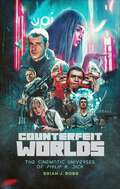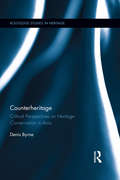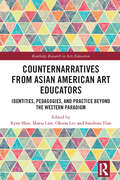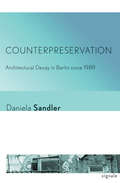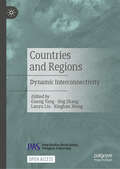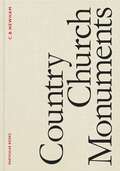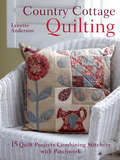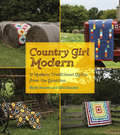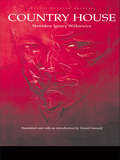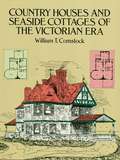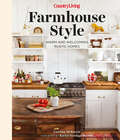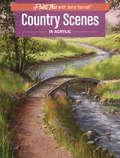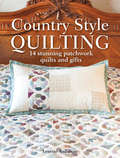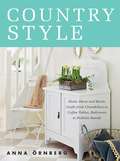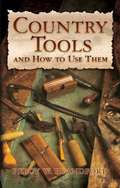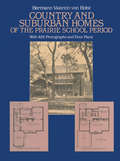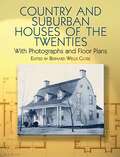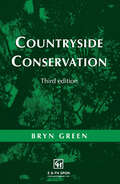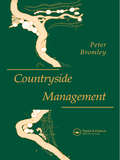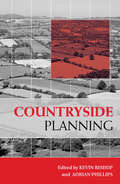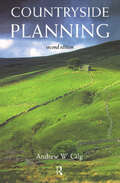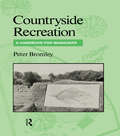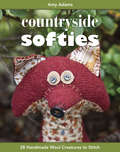- Table View
- List View
Counterfeit Worlds: The Cinematic Universes of Philip K. Dick
by Brian J. RobbDive into the worlds of Philip K. Dick who inspired some of the most famous sci-fi movies of all time! Philip K. Dick struggled to make a living during his lifetime, but his work has since served as a deep seam of ideas to be mined by filmmakers such as Ridley Scott, Paul Verhoeven, Steven Spielberg, John Woo and Richard Linklater, resulting in some of the most successful and influential SF movies of all time. For the still-unequalled future world of Blade Runner to the mind-bending A Scanner Darkly, via the blockbusting action/adventure of Total Recall, Paycheck and Minority Report – not to mention the debt of gratitude films like The Matrix and The Truman Show owe to his work – the legacy of Philip K. Dick has revolutionised Hollywood.
Counterheritage: Critical Perspectives on Heritage Conservation in Asia
by Denis ByrneThe claim that heritage practice in Asia is Eurocentric may be well-founded, but the view that local people in Asia need to be educated by heritage practitioners and governments to properly conserve their heritage distracts from the responsibility of educating oneself about the local-popular beliefs and practices which constitute the bedrock of most people’s engagement with the material past. Written by an archaeologist who has long had one foot in the field of heritage practice and another in the academic camp of archaeology and heritage studies, Counterheritage is at once a forthright critique of current heritage practice in the Asian arena and a contribution to this project of self-education. Popular religion in Asia – including popular Buddhism and Islam, folk Catholicism, and Chinese deity cults – has a constituency that accounts for a majority of Asia’s population, making its exclusion from heritage processes an issue of social justice, but more pragmatically it explains why many heritage conservation programs fail to gain local traction. This book describes how the tenets of popular religion affect building and renovation practices and describes how modernist attempts to suppress popular religion in Asia in the early and mid-twentieth century impacted religious ‘heritage.’ Author Denis Byrne argues that the campaign by archaeologists and heritage professionals against the private collecting and ‘looting’ of antiquities in Asia largely ignores the regimes of value which heritage discourse has helped erect and into which collectors and local diggers play. Focussing on the Philippines, Thailand, and Taiwan but also referencing China and other parts of Southeast Asia, richly detailed portraits are provided of the way people live with ‘old things’ and are affected by them. Narratives of the author’s fieldwork are woven into arguments built upon an extensive and penetrating reading of the historical and anthropological literature. The critical stance embodied in the title ‘counterheritage’ is balanced by the optimism of the book’s vision of a different practice of heritage, advocating a view of heritage objects as vibrant, agentic things enfolded in social practice rather than as inert and passive surfaces subject to conservation.
Counternarratives from Asian American Art Educators: Identities, Pedagogies, and Practice beyond the Western Paradigm (Routledge Research in Arts Education)
by Ryan Shin Maria Lim Oksun Lee Sandrine HanCounternarratives from Asian American Art Educators: Identities, Pedagogies, and Practice beyond the Western Paradigm collects and explores the professional and pedagogical narratives of Asian art educators and researchers in North America. Few studies published since the substantial immigration of Asian art educators to the US in the 1990s have addressed their professional identities in higher education, K-12, and museum contexts. By foregrounding narratives from Asian American arts educators within these settings, this edited volume enacts a critical shift from Western, Eurocentric perspectives to the unique contributions of Asian American practitioners. Enhanced by the application of the AsianCrit framework and theories of intersectionality, positionality, decolonization, and allyship, these original contributor counternarratives focus on professional and pedagogical discourses and practices that support Asian American identity development and practice. A significant contribution to the field of art education, this book highlights the voices and experiences of Asian art educators and serves as an ideal scholarly resource for exploring their identity formation, construction, and development of a historically underrepresented, minoritized group in North America.
Counternarratives from Asian American Art Educators: Identities, Pedagogies, and Practice beyond the Western Paradigm (Routledge Research in Arts Education)
by Ryan Shin Maria Lim Oksun Lee Sandrine HanCounternarratives from Asian American Art Educators: Identities, Pedagogies, and Practice beyond the Western Paradigm collects and explores the professional and pedagogical narratives of Asian art educators and researchers in North America. Few studies published since the substantial immigration of Asian art educators to the United States in the 1990s have addressed their professional identities in higher education, K-12, and museum contexts. By foregrounding narratives from Asian American arts educators within these settings, this edited volume enacts a critical shift from Western, Eurocentric perspectives to the unique contributions of Asian American practitioners.Enhanced by the application of the AsianCrit framework and theories of intersectionality, positionality, decolonization, and allyship, these original contributor counternarratives focus on professional and pedagogical discourses and practices that support Asian American identity development and practice. A significant contribution to the field of art education, this book highlights the voices and experiences of Asian art educators and serves as an ideal scholarly resource for exploring their identity formation, construction, and development of a historically underrepresented minoritized group in North America.
Counterpreservation: Architectural Decay in Berlin since 1989
by Daniela SandlerIn Berlin, decrepit structures do not always denote urban blight. Decayed buildings are incorporated into everyday life as residences, exhibition spaces, shops, offices, and as leisure space. As nodes of public dialogue, they serve as platforms for dissenting views about the future and past of Berlin. In this book, Daniela Sandler introduces the concept of counterpreservation as a way to understand this intentional appropriation of decrepitude. The embrace of decay is a sign of Berlin's iconoclastic rebelliousness, but it has also been incorporated into the mainstream economy of tourism and development as part of the city's countercultural cachet. Sandler presents the possibilities and shortcomings of counterpreservation as a dynamic force in Berlin and as a potential concept for other cities.Counterpreservation is part of Berlin’s fabric: in the city’s famed Hausprojekte (living projects) such as the Køpi, Tuntenhaus, and KA 86; in cultural centers such as the Haus Schwarzenberg, the Schokoladen, and the legendary, now defunct Tacheles; in memorials and museums; and even in commerce and residences. The appropriation of ruins is a way of carving out affordable spaces for housing, work, and cultural activities. It is also a visual statement against gentrification, and a complex representation of history, with the marks of different periods—the nineteenth century, World War II, postwar division, unification—on display for all to see. Counterpreservation exemplifies an everyday urbanism in which citizens shape private and public spaces with their own hands, but it also influences more formal designs, such as the Topography of Terror, the Berlin Wall Memorial, and Daniel Libeskind’s unbuilt redevelopment proposal for a site peppered with ruins of Nazi barracks. By featuring these examples, Sandler questions conventional notions of architectural authorship and points toward the value of participatory environments.
Countries and Regions: Dynamic Interconnectivity
by Jing Zhang Guang Yang Lanyu Liu Xinghan XiongThis open access book aims to present the cutting-edge research of scholars from the Global South, where scholars from developing countries have begun to join in the production of knowledges of Area Studies and have produced a large body of excellent works of Area Studies based on a variety of disciplines. Articles of this book have been developed from 11 papers which were presented at the 2nd Tsinghua Area Studies Forum, to represent a range of area studies subjects and regions. The book is divided into five chapters that either analyze regional country issues (regions in the world) from the perspective of global linkages and cross-regional linkages or discuss internal issues such as national governance, ethnicity, economy, and civil war, using the nation-state as the unit of analysis.
Country Church Monuments
by C. B. NewhamA landmark illustrated history of rural church monuments - the forgotten national treasures of England and WalesDeep in the countryside, away from metropolitan abbeys and cathedrals, thousands of funerary monuments are hidden in parish churches. These artworks - medieval brasses and elegant marble effigies, stone tomb chests and grand mausoleums - are of great historical and cultural significance, but have, due to their relative inaccessibility, faded from accounts of our art history.Over twenty-five years, C. B. Newham FSA has visited and photographed more than eight thousand rural churches, cataloguing the monumental sculptures encountered on his quest. In Country Church Monuments, he presents 365 of the very best, each accompanied by detailed photographs, biographies of both the deceased and their sculptors and a wealth of contextual material. Many of these works commemorate famous historical figures, from scheming Tudor courtier Richard Rich to Victorian prime minister William Ewart Gladstone. But more moving are the countless others - minor aristocrats, small-time industrialists, much-loved mothers, fathers and children - who, if not for their memorials, would wholly be lost to time.As Newham blows the dust off these artworks and breathes life into the stories they tell, a new aesthetic history of rural England and Wales emerges. Country Church Monuments is a poignant record of the art we make at the borders of life and death, of our ceaseless human striving for eternity.
Country Cottage Quilting: 15 Quilt Projects Combining Stitchery with Patchwork
by Lynette AndersonLearn how to make gorgeous quilting, patchwork, applique and sewing projects with Country Cottage Quilting, from bestselling author and fabric designer Lynette Anderson. Lynette's country cottage garden provides the inspiration for this collection of 15 beautiful projects, from quick-to-stitch applique designs that make ideal gifts to larger wall hangings and bed-sized quilt patterns. The stunning designs combine charming hand embroidery with traditional patchwork and quilting techniques. Beautiful fabrics, warm colours and a homely feel are enhanced by a book design that captures Lynette's heart-warming, quirky style. Inside Country Cottage Quilting: Patchwork and Applique Projects - 15 projects for you to make at home, from quilts and cushions to wall hangings, scissor keepers and sewing cases. Techniques - all the sewing, patchwork and applique techniques you need to know to make the projects. In this book you will learn about sewing seams, pressing work, needle-turn applique, English paper piecing, how to make yo yos, how to quilt, and more, and you will also find a comprehensive guide to all of the embroidery stitches that Lynette uses.
Country Girl Modern: 11 Modern Traditional Quilts from the Junction
by Jo Kramer Kelli HankenModern quilting meets country style in these 11 patterns from the mother-daughter design team behind Jo&’s Country Junction. Jo Kramer and her daughter Kelli Hanken have been quilting together for years, sharing their unique designs through their brand Jo&’s Country Junction. Now they&’re bringing modern quilting to the country with 11 updated quilts inspired by open air, traditional roots and contemporary fun. Country Girl Modern features a quilt for a modern-day patriot, a vintage modern design, and an Amish-inspired quilt, among others.
Country House: Polish Theatre Archive
by Stanislav I. Witkiewicz D. GerouldCountry House, a ''comedy with corpses,'' is a wicked subversion of all those realistic psychological dramas of jealousy, adultery, murder and suicide that ask to be taken seriously. Witkacy's send-up assumes the form of a ghost story full of surprises, in the course of which an entire family of four is gleefully dispatched to the other world. When it was first performed in 1923 in Torun, Country House was judged unsuitable for the general public because it derided moral, social and dramatic convention. Three years later, as directed by the playwright himself in Lwów, the drama proved an unexpected success with audiences (although it only ran for four nights) and ever since has been among Witkacy's most frequently performed works. Today we can appreciate Country House not only as a systematic demolition of stage realism, but also as an anxious probing of the elusive boundaries between life and death, exposing the ''dark places'' of the human psyche that make us laugh nervously.
Country Houses and Seaside Cottages of the Victorian Era
by William T. ComstockThis fascinating book presents a series of 44 designs for vacation homes of varying styles and sizes, created over a century ago by a select group of New York and New Jersey architects. Many of them are two-story, and most were intended to be built on low-to-medium budgets. All of them reflect the ideals of comfort and charm and state-of-the-art technology of the Victorian period.The original publishers compiled a splendid variety of designs, presented them as "seaside and country houses" and included designs for a Victorian club house, pavilion, school house, and a "small seaside chapel." A total of 200 illustrations -- including perspective views, front and side elevations, and first- and second-story floor plans -- depict these appealing designs. Occasionally the architects have specified construction materials and finishing details such as paint, color, and trim, and in all cases they have included the overall anticipated costs, which range from about $500 to about $9,000.The Victorians, of course, loved architectural embellishments of every kind, and it is no small part of the charm of this book to study the profusion of gables, porches, portholes, dormers, porticoes, chimneys, pinnacles, and more, lavished on even the most modest designs. Above all, the houses and cottages appear to be both comfortable and reassuring, appealing reminders of a gracious age long gone. Those studying and working in the fields of architecture, history, and sociology will find in this wonderful book exuberant examples of a rich and charming architectural style. Those who wish to join the growing number of home builders and restorers re-creating Victorian homes will find inspiration in each of these thoughtful designs.
Country Living Farmhouse Style: Warm and Welcoming Rustic Homes
by Caroline McKenzieAdd rustic country charm and make home your favorite place to be. This collection of classic and modern farmhouses inspire easy and comfortable living. Farmhouse style is about cultivating connection, embracing the simple life, and bringing a kick-up-your-feet, linger-a-little-longer feeling to your home. Step inside 20 beautifully-designed homes and discover how to create the cozy and practical country vibe. An intimate look inside these homes reveals how designers blend elements of old and new and add a touch of distinctive character to every room. You&’ll tour a renovated New York farmhouse that pairs classic architecture with a fresh color palette for a hip yet historic look and discover how designer Lauren Leiss artfully refreshes a Virginia Colonial-style home with reclaimed floors and exposed beams. Plus, peek inside a ranch-style Texas home built from scratch which displays old-time charm inside and out. (Think: tons of textured cozy lived-in rooms featuring aged furniture and collections of time-worn books and oiled paintings.)Whether you are looking to upgrade your kitchen with an apron-front sink, add shiplap to your walls, or introduce flair to your living space with flea market finds, this expansive collection of farmhouses will inspire homeowners who plan to renovate or decorate a new home or make the perfect gift for anyone who dreams of a farmhouse of their own.
Country Living Mini Makeovers: Easy Ways to Transform Every Room
by Country LivingWhen it&’s time for a quick change, these 250 mini-makeovers for your home are fun and easy! No major remodeling necessary! Sometimes, all it takes are a few small changes to refresh your home and make you happy. These micro-decorating ideas from Country Living add beauty to every room, whether you&’re swapping your old coffee table for an antique bench, creating an eye-catching display in a passageway, or energizing your bedroom by playing with different patterns. You&’ll discover new possibilities for things to do, make, buy, and repurpose, and every chapter shows how to revive any space, from living and dining rooms to entryways, mudrooms, home offices, and porches. These fun mini-decorating moves can be as simple as selecting a dark wall color to cozy up a bedroom, showcasing vintage mirrors in the bathroom, or covering stair risers with whimsical floral wallpaper. You&’ll also find projects like decoupaging a dresser or tricking out a plain kitchen screen door—and most of them can be done in just one weekend. Pack a punch with simple switches for any space!Transform any room—one easy, inspirational idea at a time.
Country Scenes in Acrylic (Paint This with Jerry Yarnell)
by Jerry YarnellBest-selling author, instructor and PBS TV show host, Jerry Yarnell delivers his latest offering with dozens of all new lessons and 8 full step-by-step landscape painting projects. Features detailed materials lists and advice on how to set up a palette. Learn the terms and techniques necessary to achieve your desired effects. Get lessons on color mixing, composition, negative space, perspective, values and more. With his signature, easy-to-follow style, Jerry Yarnell provides the instruction needed to help you learn how to bring life and beauty to your acrylic landscape paintings.Tips on choosing supplies and setting up your painting studioTechniques for painting the sky, rivers, meadows, flowers, cottages, barns and many other elements of country landscapesEasy-to-follow step-by-step instruction walks you through 8 complete painting demonstrations
Country Style Quilting: 14 Stunning Patchwork Quilts and Gifts
by Lynette AndersonBring the feel of the countryside into your home with this unique collection of patchwork quilts and gifts from quilt designer, Lynette Anderson.Lynette's inspiration comes from nature, her garden and her animals, and all of these are reflected in this new collection of patterns. The designs in this title feature birds and flowers, with lots of hand embroidery and stitching, including great portable projects for stitching 'on the go'.All the basic techniques you will need to make and finish off the projects are detailed, from transferring designs onto fabric to binding a finished quilt. Instructions also cover hand stitching techniques for the embroidery.15 fabulous projects to make including: a sewing basket and scissor holder; lap size quilt using English paper pieced hexagons and elongated hexagons; craft case cover, small wall quilt/stitchery, framed stitchery, plus full-size bed quilts.
Country Style: Home Décor and Rustic Crafts from Chandeliers to Coffee Tables, Bedcovers to Bulletin Boards
by Anna ÖrnbergA beautiful, rustic home isn't hard to create. With a splash of color, some pieces that pop, and a little bit of inspiration, even the most standard unit can be flipped into a country haven. Try elegant whites, industrial details, grandiose patterns, or some shabby chic. It's fun, easy to accomplish, and the results will make you proud. Liven up your space with such projects as: Vintage silhouette art Antique book decor Military bed covers Door frame bulletin boards Wallpapering, crocheting, decoupage, and more!So take a quick trip to the flea market, the thrift store, or even the attic-it'll trigger the impulse to decorate! Plus, crafting and decorating is the best form of stress-relief. Paint, sew, sand, sculpt-work with your hands to clear your mind and make your home beautiful in the process. Featuring patterns, step by steps, and over 100 photos, Country Style is the perfect how-to for decorators of all experience levels and with any type of home.
Country Tools and How to Use Them
by Percy W. BlandfordCountry craftworkers have traditionally relied on tools that evolved over centuries. A revival of interest in these handmade implements has led to an increased demand for information on craftsmen's techniques; but up to now, mention of their tools has been incidental and incomplete. This book examines specific tools on which workers have long relied, and for ease of reference, groups them according to use rather than craft. Authoritatively written and expertly arranged by a master craftsman and instructor, this volume examines in detail dozens of early tools and their functions. More than seventy drawings and photographs accurately depict--among other devices--chopping and splitting tools, hammers and knives for a variety of uses, chisels, gouges, and saws; planes and drills, vices and cramps, hole-making tools, tools for working the soil, as well as equipment for blacksmithing, spinning, weaving, and baking.An invaluable resource for hobbyists, collectors, and museum curators, this volume will also be prized by lovers of traditional ingenuity and know-how.
Country and Suburban Homes of the Prairie School Period (Dover Architecture)
by H. V. HolstOver 400 photographs, floor plans, elevations, detailed drawings — exteriors and interiors — for over 100 structures of Prairie School period. Complemented by author's concise text. Important primary source.
Country and Suburban Houses of the Twenties: With Photographs and Floor Plans
by Bernard Wells CloseReprint of rare book contains scores of illustrations and floor plans for 80 charming American homes, among them a spacious Pennsylvania fieldstone colonial; a modest, three-bedroom suburban bungalow; and an artist's two-story studio/residence in California. An invaluable primary reference for architects and students of architectural history. 104 black-and-white illustrations.
Countryside Conservation: Land Ecology, Planning and Management
by Bryn GreenThis third edition of the standard text Countryside Conservation charts and evaluates those changes which represent a fundamental revolution in the ways in which the countryside is planned and managed. It sets out the principles, policies and practice which underlie the ecology, planning and management of the new countryside, discussing ways in which countryside conservation objectives are evolving and how they can best be achieved.
Countryside Management
by Mr Peter BromleyThis management handbook explains the skills and systems needed by all those involved in managing the countryside. It deals with the process of management, national trends, establishing local policies and priorities, implementing schemes, as well as the legislation which surrounds countryside management.
Countryside Planning: New Approaches to Management and Conservation
by Kevin Bishop Adrian PhillipsNot since the 19th century has the future of the countryside been such a focus of political and public attention, nor of profound uncertainty and anguished debate. A watershed has now been reached, and in this time of unprecedented change, new tools are needed for planning and managing the countryside. Increasingly the 'drivers' of countryside management and conservation are European and international. They aim to provide comprehensive new frameworks for the whole countryside, and encourage community-driven planning and protection. There have been numerous responses at the country and local levels within the UK. In this book, a broad range of scholars and practitioners review the international drivers affecting countryside policy and practice, and - through a variety of case studies - they assess the value of country and local responses. The result is a powerful and coherent volume that provides a fully up-to-date review and analysis of the pressures on the countryside, the policies for the future and the keys to successful implementation. Countryside Planning is essential reading for planners, local authorities and rural organizations, conservationists and environmental groups, as well as academics and students in planning, rural studies, environmental studies and geography.
Countryside Planning: The First Half Century
by Andrew GilgShould rural Britain be preserved from urban development, or should people be allowed to live and shop where they want? In the face of continued urban expansion the countryside has become a major issue, its future development uncertain. Countryside Planning addresses these concerns and provides an in-depth study of the rural debate. Beginning with the key concepts and issues, the author sets out the context in which planning operates and how society has constructed its own images of the countryside. Using three theoretical perspectives the book decsribes the evolution of the current planning system and provides a basis for further discussion about the possible future for the countryside. In the wake of the recent Rural White Paper, the book includes the major issues that affect contemporary rural Britain including the current reforms of the CAP, the role of farmers as land managers, and the hypocrisy of sustainable and green tourism. Using boxed policy summaries throughout the text, as well as key question and answer sections in every chapter, the author treats policy and trends across the whole spectrum of countryside planning. Countryside Planning is an in-depth and authoritative analysis of rural policy and makes an important contribution to the countryside planning debate and the future of rural Britain.
Countryside Recreation: A handbook for managers
by Peter Bromley Mr Peter BromleyCountryside Recreation outlines the principles of recreation site development and management in the countryside. It explains the process of management, the legal framework and the opportunities and facilities available. This book will provide an excellent introduction to the skills and issues with which today's countryside recreation managers need to be familiar. It is designed to be used as a concise management handbook with checklists, management plans and appendices of useful information.
Countryside Softies: 28 Handmade Wool Creatures to Stitch
by Amy AdamsCreate your own adorable stuffed animals—including foxes, hedgehogs, bumblebees and more—with this guide for crafters of all skill levels.A little time, a few supplies, and a dash of creativity are all you need to bring these adorable critters to life. Whether it's a fuzzy rabbit personalized as a gift, or a charming family of birds to display in your home, this playful guide features easy-to-follow patterns, clear instructions, and enchanting photography of the creatures in their natural habitats. Best of all, each project is graded according to difficulty (easy, moderate, and slightly tricky) so both experienced and beginner sewers can share in the fun.• 28 unique fabric softies that can be sewn by hand or machine• Learn how to personalize your creation with a variety of whimsical embellishments• With these forgiving patterns, imperfect stitches make these cuties even cuter!
